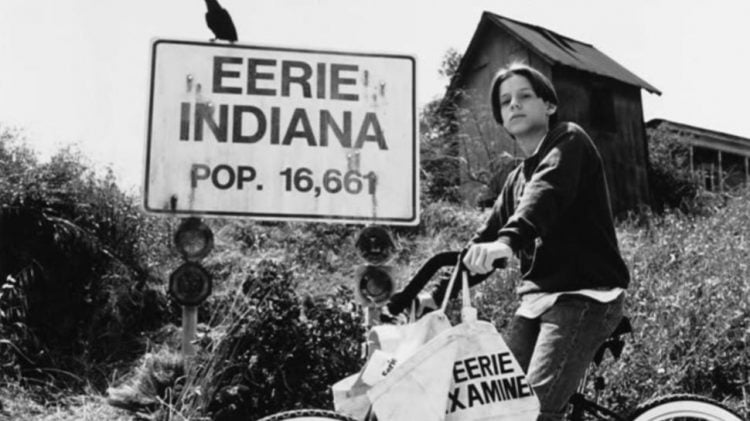The short-lived TV series “Eerie, Indiana” will always have a special place in my heart. A mix of sci-fi/ supernatural/ mystery genres aimed at young adults, “Eerie” was definitely ahead of its time when it premiered on NBC in 1991, a full two years before the “adult” show its most compared to, “The X-Files.” Since it was not only released in the prime of my adolescence (I was a young, bright-eyed lad of 13 when the show first aired) but also took place in and made reference to my home state right in the title, I was easily hooked. Like so many fond remembrances from our youth, however, a reconnection with this series as an adult has sadly shown me that my memories of the show were viewed through rose-colored glasses.
“Eerie” follows a young boy named Marshall Teller, who moves with his family to Eerie (population 16,661, whether this was before or after his family joined the community is unclear, natch), a small town in Indiana with some seriously strange goings-on. While my understanding is that Eerie was not specifically based on the template of any one town, its name was obviously a play on the real-life town of Erie, Indiana, although I haven’t found any information or documentation that the real-life town embraced its fictitious counterpart in any way.
While the show lasted only one season on NBC, it did see a moderate revival in syndication in the late ‘90s on Fox and The Disney Channel, enough so that a spin-off series, “Eerie, Indiana: The Other Dimension” was produced for the Fox Kids Network in 1998 (it lasted only one season as well). Both series tackled a variety of odd situations and famous legends and folklore, including stories revolving around Bigfoot, Elvis Presley, Captain Ahab, and even the infamous jackalope.
I have a special place in my heart for zombies, and two episodes from the original series centered around the undead, even if they did use the term a little loosely. But c’mon, it was a kids show on a national network channel, how much flesh-eating and carnage can you really expect?
“Just Say No Fun” is the sixth episode of the series and revolves around Marshall and his friend Simon going for what seems to be a routine eye examination with the School Nurse. But as things tend to go in Eerie, both the Nurse and the exam are far from routine, and after Simon and the other students turn into “homework-loving zombies,” it’s up to Marshall to avoid his exam and discover what’s going on. In the later episode “Zombies in P.J.s,” most of the townspeople are brainwashed by a slick ad executive into becoming “consumer zombies” – folks who will sleepwalk to his store and buy whatever he’s selling, and once again it falls to Marshall to figure the situation out and set things right.
While both stories were interesting in their own right, they both used very “kid-friendly” versions of zombies, and the line between catering to a young adult audience and pandering to them is extremely thin. Currently, there is quite a positive movement towards zombie stories geared towards the younger crowd, and I fear that “Eerie” was just a little ahead of the curve in their timing and a little behind the curve in the amount of respect they gave their audience’s intelligence.
I give this series credit for doing something that no one else was doing on television at the time. As for the “zombies” themselves, they are in no way the undead, flesh-craving creatures we adults have come to know and love. In fact, most folks may not see the characters in these two stories as zombies at all, but for the purposes and definition of this website, they are in the “broad spectrum” and most definitely count. Also, this series featured a lot of cameos by actors, young and largely unknown at the time, that would go on to high-profile acting careers, including Tobey Maguire, Nikki Cox, Vincent Schiavelli, Matt Frewer, and Rene Auberjonois – Auberjonois starring in “Zombies in P.J.s” as the particularly wacky, slick ad executive known as “The Donald.”
Even when I was watching this series as a youth, I remember thinking frequently “Yeah, right, that would never happen.” I think shows like “Kolchak: The Night Stalker” and “The X-Files” have proven that you can craft supernatural mystery stories and still have them retain a realistic feel. Both of these episodes, along with the entire “Eerie” series, never really seemed to find this balance, with goofy-looking characters, kitschy dialogue, and half-hearted conclusions to the tales all combining to make for a very disappointing experience.
I do have to give “Eerie” some credit in their effective use of the format, as they do manage to pack some interesting storylines into about 22 minutes of screen time per TV episode. But as much as I can give for editing, I have to take away for effects, as they were essentially non-existent. Granted, these weren’t your traditional zombies and as such didn’t need heaping piles of blood and entrails or anything like that, but in both episodes the “zombies” looked exactly like normal people, just with different facial expressions or, worse, in “Zombies in P.J.s,” with the always-lame “sleepwalking zombie” pose where people stagger around with their arms out in front of them. Yeesh.
“Eerie, Indiana” was fun to watch as a youngster back in the day, but I’m sorry to say that it doesn’t hold much in the way of long-term entertainment value. However, if you have youngsters in the home, and they enjoy scary-but-not-really-scary fare like Goosebumps and the like, “Eerie, Indiana” could be a fun find for them!

